Manually locking your garage door provides an extra layer of security, ensuring protection during power outages and offering peace of mind with a simple, reliable method;
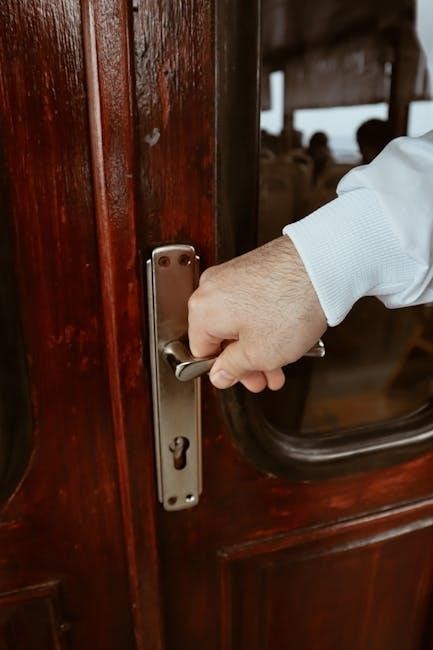
Why Manually Locking Your Garage Door is Important
Manually locking your garage door enhances security, providing protection against break-ins, severe weather, and unauthorized access while safeguarding your belongings and ensuring peace of mind․
2․1․ Security During Power Outages
Power outages can disable automatic garage door openers, leaving your garage vulnerable․ Manually locking ensures security, preventing unauthorized access and protecting your belongings from potential intruders during such situations․
2․2․ Added Layer of Security Against Break-Ins
Manually locking your garage door adds an extra layer of protection against break-ins․ Intruders often target garages with automatic openers, but a manual lock creates a physical barrier, deterring potential burglars and safeguarding your belongings effectively․
2․3․ Protection Against Severe Weather
Manually locking your garage door provides additional protection against severe weather․ Strong winds, storms, or extreme conditions can damage an unlocked door or cause it to shift out of alignment․ By securing it manually, you create a tighter seal and prevent potential damage from weather-related forces․
This extra step ensures your garage door remains closed and secure, safeguarding both the door itself and the items stored inside․ It also offers peace of mind during harsh weather conditions․ Regular maintenance of the locking mechanism is key to ensuring reliability․
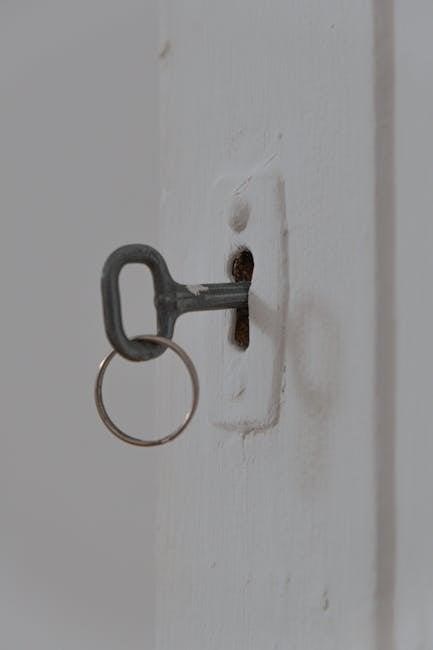
Step-by-Step Guide to Manually Locking a Garage Door
Manually locking your garage door involves disengaging the automatic opener, locating the manual lock mechanism, and securing the door with a padlock or slide bolt for added safety․
3․1․ Disengage the Automatic Garage Door Opener
To manually lock your garage door, start by disengaging the automatic opener․ Locate the emergency release cord, typically a red handle or rope, hanging from the opener rail․ Pull it down to disconnect the door from the opener․ This allows manual control, ensuring the door can be secured without relying on the automatic system․ Always disengage the opener when the door is fully closed to avoid misalignment and potential damage․ Once disconnected, the door is ready for manual locking․
3․2․ Locate and Use the Manual Lock Mechanism
After disengaging the automatic opener, locate the manual lock mechanism, usually found near the emergency release handle․ It often resembles a small box with a lever or knob inside․ Engage the lock by sliding it into place or turning the knob to secure the door․ If your door lacks this feature, consider installing one for added security․ Ensure the lock is fully engaged and test it by attempting to open the door from the outside to confirm it’s secure․
3․3․ Secure the Door with a Padlock or Slide Bolt
For enhanced security, use a padlock or slide bolt to reinforce the manual lock․ Attach the padlock to the lock bar or handle, ensuring it’s tightly secured․ Alternatively, slide the bolt into the locking mechanism and fasten it firmly․ This adds an extra layer of protection, making it difficult for intruders to force the door open․ Always choose a sturdy padlock or bolt to maximize security and ensure your garage remains protected․
3․4․ Reinforce the Lock with Zip Ties or Cable Locks
For added security, use zip ties or cable locks to reinforce the manual lock․ Thread the zip tie through the lock bar and tighten it, or loop the cable lock around the locking mechanism and secure it․ This creates an additional barrier, making it harder for intruders to force the door open․ While not foolproof, these methods deter potential break-ins and provide extra peace of mind․ Use heavy-duty zip ties or a high-strength cable lock for maximum effectiveness․
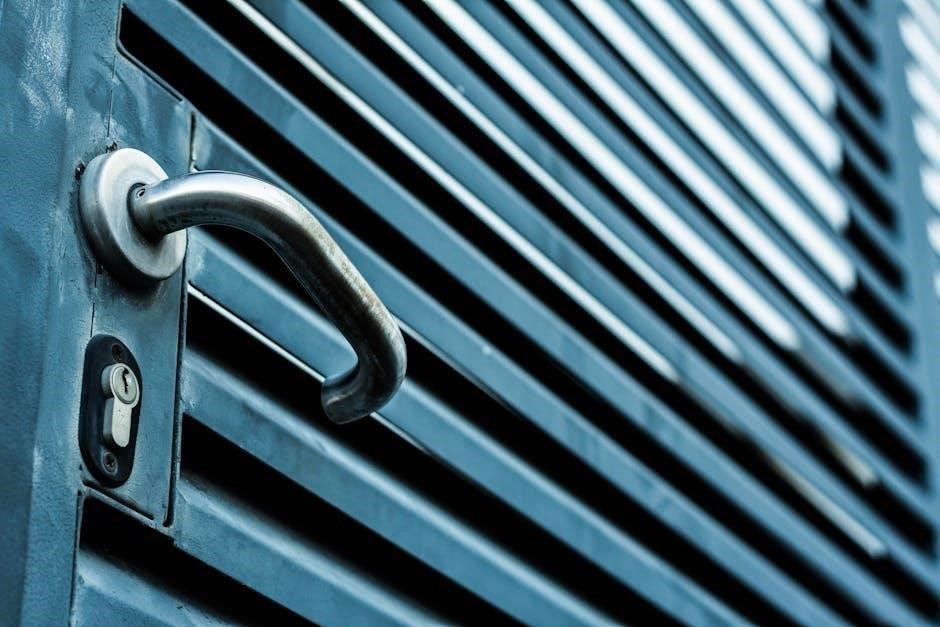
Common Mistakes to Avoid When Manually Locking a Garage Door
Avoid forgetting to close the door fully and not double-checking the lock․ These oversights can compromise security, leaving your garage vulnerable to unauthorized access․
4․1․ Forgetting to Close the Door Fully Before Locking
One common mistake is neglecting to ensure the garage door is completely closed before locking․ A partially open door can render the lock ineffective, allowing easy access․ Always verify the door is fully shut and aligned properly with the frame․ This simple oversight can leave your garage vulnerable, making it essential to develop a habit of double-checking the door’s position before securing it manually․ Proper alignment ensures the lock functions as intended, providing the desired security․
4․2․ Not Double-Checking the Locking Mechanism
Failing to double-check the locking mechanism is a critical error that can compromise garage security․ Even if the door appears locked, a quick test by attempting to open it from the outside ensures the lock is fully engaged․ Neglecting this step can leave the door vulnerable, allowing easy access for intruders․ Taking a moment to verify the lock’s effectiveness is a simple yet crucial measure to reinforce your garage’s security without requiring additional tools or equipment․
Additional Tips for Enhanced Garage Door Security
Enhance your garage door security by installing smart locks, reinforcing hinges, and using tamper-proof screws․ Ensure all parts are secure to prevent unauthorized access effectively for added protection․
5․1․ Installing a T-Handle Lock
A T-handle lock enhances garage door security by providing an additional layer of protection․ It operates via a key, ensuring only authorized individuals can lock or unlock the door․ The lock is typically installed on the exterior, making it difficult for intruders to access․ This mechanism is durable and offers peace of mind, especially when combined with other manual locking methods․ It’s a simple yet effective upgrade to boost home safety and deter potential break-ins effectively․
5․2․ Using a Sliding Bolt Lock
A sliding bolt lock is a popular and effective method for manually securing a garage door․ It consists of a metal bolt that slides into a receiver on the door frame, ensuring the door remains closed․ This lock is easy to operate and provides a visible deterrent to potential intruders․ The bolt is typically made of heavy-duty materials, offering durability and resistance to tampering․ It’s a straightforward solution that adds an extra layer of security, especially when used alongside other locking mechanisms․
5․3․ Regular Maintenance of Locking Mechanisms
Regular maintenance of locking mechanisms is crucial for ensuring the security and functionality of your garage door․ This includes lubricating hinges and springs to prevent rust and wear, inspecting bolts and locks for damage, and tightening any loose screws․ Clean the locking bars and ensure smooth operation․ Additionally, check the condition of padlocks and replace them if necessary․ These simple steps prevent malfunctions and ensure your manual locks remain effective and reliable over time․
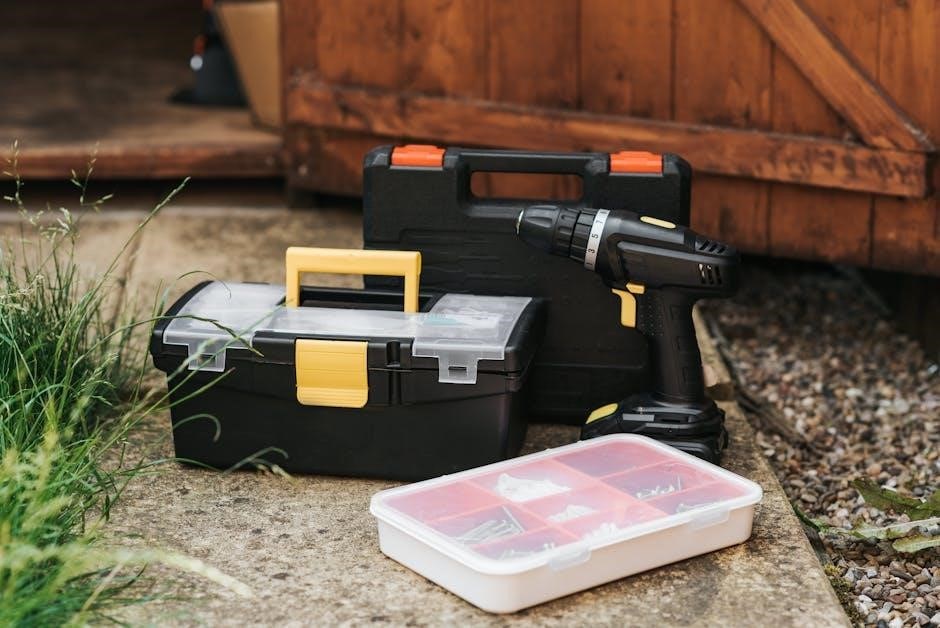
Tools and Materials Needed for Manual Locking
To manually lock a garage door, you’ll need essential tools and materials․ These include a slide bolt or padlock for added security, zip ties or cable locks to reinforce the door, and lubricants for smooth operation․ Additionally, a screwdriver may be necessary for adjustments, and a red emergency release cord is often required to disengage the automatic opener․ Having these items ensures you can secure your door effectively and maintain its locking mechanisms properly․

Types of Manual Locking Mechanisms
Common types of manual locking mechanisms include slide bolt locks, key-operated locks, T-handle locks, and cable locks, each offering unique security benefits and ease of use․
7․1․ Slide Bolt Locks
Slide bolt locks are a popular choice for manually securing garage doors․ They consist of a metal bolt that slides into a receptor on the door frame, providing a sturdy barrier against forced entry․ These locks are easy to install and operate, with a simple sliding mechanism that can be secured with a padlock for added security․ Their durability and effectiveness make them a reliable option for enhancing garage door safety․
7․2․ Key-Operated Locks
Key-operated locks offer enhanced security for garage doors․ These locks require a key to engage or disengage, ensuring only authorized access․ Ideal for homeowners seeking an additional layer of protection, they can be installed on various garage door types․ Their effectiveness lies in their resistance to tampering, making them a popular choice for those prioritizing security․ However, it’s important to keep the key in a safe and accessible location to avoid being locked out․
7․3․ T-Handle Locks
T-handle locks are a reliable option for manually securing garage doors․ These locks feature an exterior handle that operates an internal locking mechanism․ They provide a visible and robust security solution, often requiring a key to lock or unlock․ T-handle locks are user-friendly and can be installed on various garage door types, making them a versatile choice for homeowners seeking durable and effective manual locking systems․
7․4․ Cable Locks
Cable locks offer a flexible and durable solution for manually securing garage doors․ These locks consist of a sturdy cable and a locking mechanism, allowing you to wrap the cable around the door and frame․ They provide an additional layer of security and can be used in combination with other locks․ Cable locks are easy to install and offer a high level of protection against unauthorized access, making them a practical choice for enhancing garage door security․
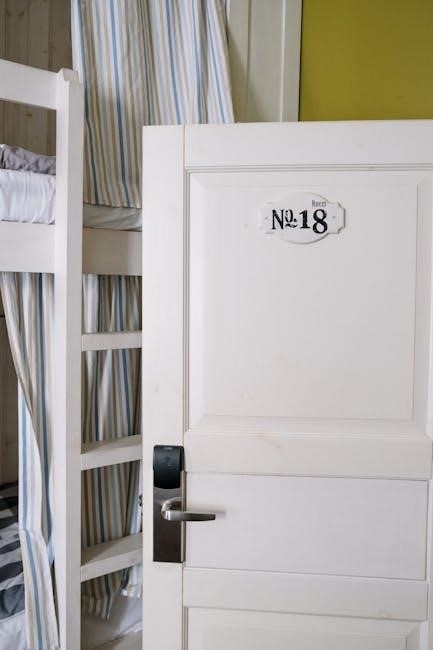
How to Choose the Right Lock for Your Garage Door
Selecting the right lock for your garage door involves considering security needs, door type, and personal preferences․ Assess the door’s material and structure to determine the most suitable lock․ Slide bolts and T-handle locks are ideal for sectional doors, while cable locks offer flexibility for various door types․ Evaluate durability, ease of installation, and resistance to tampering․ Choosing a lock that complements your door’s mechanism ensures effective security and long-lasting performance․ Prioritize locks with robust materials and reliable locking systems for optimal protection․

Garage Door Types and Their Locking Mechanisms
Sectional, tilt-up, roll-up, and side-sliding garage doors each require specific locking mechanisms tailored to their design for optimal security and functionality․
9․1․ Sectional Garage Doors
Sectional garage doors, composed of multiple panels, often use slide bolts or key-operated locks for manual locking․ These mechanisms provide durable security by engaging with the door frame, ensuring stability and resistance to forced entry․ They are easy to install and operate, making them a popular choice for homeowners seeking reliable manual locking solutions․ Regular maintenance of these locks ensures optimal performance and long-lasting protection for your garage and its contents․
9․2․ Tilt-Up Garage Doors
Tilt-up garage doors use a simple locking mechanism often involving a rod or bar that secures the door to the floor or frame․ This method ensures stability and prevents unauthorized access․ The locking system is typically easy to engage and offers reliable security․ Regular inspection of the locking components is essential to maintain effectiveness and protect against potential breaches or damage over time․
9․3․ Roll-Up Garage Doors
Roll-up garage doors feature a unique design with horizontal tracks and a rolling system․ To manually lock them, locate the slide bolt or padlock mechanism along the door’s edge or track․ Close the door fully and secure it by sliding the bolt into place or adding a padlock․ This provides an additional physical barrier, ensuring the door cannot be easily forced open․ Regular maintenance of the rollers and tracks is essential to maintain smooth operation and security effectiveness․
9․4․ Side-Sliding Garage Doors
Side-sliding garage doors open horizontally and often feature multiple panels․ To manually lock them, use a slide bolt or key-operated lock located at the door’s center or side․ Ensure the door is fully closed and aligned with the frame for proper security․ Additional measures like a padlock or zip ties can reinforce the lock, providing extra protection against unauthorized access and potential breaches․

Maintenance Tips for Garage Door Locks
Regular maintenance ensures optimal performance of garage door locks․ Lubricate hinges and moving parts annually to prevent rust and wear․ Inspect locks for damage or misalignment and replace worn components promptly․ Clean the locking mechanism to remove dirt and debris, ensuring smooth operation․ Test locks quarterly by attempting to open the door while locked․ Address any issues immediately to maintain security and functionality over time․
Manually locking your garage door is a practical and effective way to enhance security and protect your belongings․ By following simple steps and maintaining your locking mechanisms, you ensure peace of mind and safeguard against potential threats․ Regular maintenance and awareness of common mistakes can further strengthen your garage door’s security, making manual locking a reliable and essential practice for homeowners․